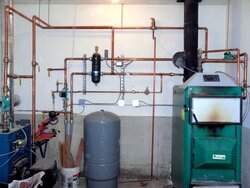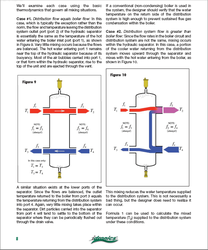When I installed my system i did not want to use a thermostatic valve for boiler protection, I decided rather to use an additional circulator with a Tekmar control.
Because I have 2 recycled tanks in my system I was concerned about sediment & debris, and was going to put in a Y strainer, but decided instaed to use a Caleffi hydroseperator. The piping became much simpler, but now that its running for a few months, I'm thinking that the recirculation pump was unnecessary.
I have The EKo controller set to turn on the pump at 160- adding heat into the primary loop. An Aquastat on that loop also set at 160 turns on the circulator that sends water to my storage, and heating loads.
In operation the boiler runs 160-170 and the secondary pump cycles until the return temperature from storage starts to rise and then boiler temperature will rise towards the setpoint. In practice at 190 I no longer need a fire because my storaage is 185.
We have built primary loops for twinned boiler installs ( which mine is), and mod - con boiler installation, and I'm sold on the hydroseperator as an economical way to accomplish primary secondary piping with air elimination.
I'm thinking that it will in my case provide boiler protection as well, eliminating the return loop, Danfoss, or pump and control. I haven't turned off the recirculating pump yet, but I plan to one of the next few days when I can be close to the system and monitor it.
Any thoughts from you wetheads?
Because I have 2 recycled tanks in my system I was concerned about sediment & debris, and was going to put in a Y strainer, but decided instaed to use a Caleffi hydroseperator. The piping became much simpler, but now that its running for a few months, I'm thinking that the recirculation pump was unnecessary.
I have The EKo controller set to turn on the pump at 160- adding heat into the primary loop. An Aquastat on that loop also set at 160 turns on the circulator that sends water to my storage, and heating loads.
In operation the boiler runs 160-170 and the secondary pump cycles until the return temperature from storage starts to rise and then boiler temperature will rise towards the setpoint. In practice at 190 I no longer need a fire because my storaage is 185.
We have built primary loops for twinned boiler installs ( which mine is), and mod - con boiler installation, and I'm sold on the hydroseperator as an economical way to accomplish primary secondary piping with air elimination.
I'm thinking that it will in my case provide boiler protection as well, eliminating the return loop, Danfoss, or pump and control. I haven't turned off the recirculating pump yet, but I plan to one of the next few days when I can be close to the system and monitor it.
Any thoughts from you wetheads?




